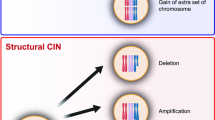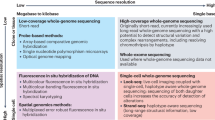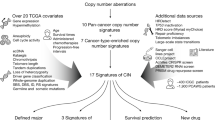Abstract
Whole chromosome instability (CIN) is a common feature of cancer cells and has been linked to increased tumor evolution and metastasis. Several studies have shown that the loss of the pRB tumor suppressor causes mitotic defects and chromosome mis-segregation. pRB is inactivated in many types of cancer and this raises the possibility that the loss of pRB may be a general cause of CIN in tumors. Paradoxically, retinoblastoma tumor cells have a relatively stable karyotype and currently the circumstances in which pRB inactivation causes CIN in human cancers are unclear. Here we utilize a fluorescence in situ hybridization-based approach to score numerical heterogeneity in chromosome copy number as a readout of CIN. Using this technique, we show that high levels of CIN correlate with the combined inactivation of pRB and p53 and that this association is evident in two independent panels of cancer cell lines. Retinoblastoma cell lines characteristically retain a wild-type TP53 gene, providing an opportunity to test the relevance of this functional relationship. We show that retinoblastoma cell lines display mitotic defects similar to those seen when pRB is depleted from non-transformed cells, but that the presence of wild-type p53 suppresses the accumulation of aneuploid cells. A similar synergy between pRB and p53 inactivation was observed in HCT116 cells. These results suggest that the loss of pRB promotes segregation errors, whereas loss of p53 allows tolerance and continued proliferation of the resulting, genomically unstable cancer cells. Hence, it is the cooperative effect of inactivation of both pRB and p53 tumor suppressor pathways that promotes CIN.
This is a preview of subscription content, access via your institution
Access options
Subscribe to this journal
Receive 50 print issues and online access
$259.00 per year
only $5.18 per issue
Buy this article
- Purchase on Springer Link
- Instant access to full article PDF
Prices may be subject to local taxes which are calculated during checkout




Similar content being viewed by others
References
Hanahan D, Weinberg RA . Hallmarks of cancer: the next generation. Cell 2011; 4144: 646–674.
Lengauer C, Kinzler KW, Vogelstein B . Genetic instability in colorectal cancers. Nature 1997; 386: 623–627.
Rajagopalan H, Lengauer C . Aneuploidy and cancer. Nature 2004; 432: 338–341.
Albertson DG, Collins C, McCormick F, Gray JW . Chromosome aberrations in solid tumors. Nat Genet 2003; 34: 369–376.
Beroukhim R, Mermel CH, Porter D, Wei G, Raychaudhuri S, Donovan J et al. The landscape of somatic copy-number alteration across human cancers. Nature 2000; 463: 899–905.
Hanahan D, Weinberg RA . The hallmarks of cancer. Cell 2000; 100: 57–70.
Choi CM, Seo KW, Jang SJ, Oh YM, Shim TS, Kim WS et al. Chromosomal instability is a risk factor for poor prognosis of adenocarcinoma of the lung: Fluorescence in situ hybridization analysis of paraffin-embedded tissue from Korean patients. Lung Cancer 2009; 64: 66–70.
Gao C, Furge K, Koeman J, Dykema K, Su Y, Cutler ML et al. Chromosome instability, chromosome transcriptome, and clonal evolution of tumor cell populations. Proc Natl Acad Sci USA 2007; 104: 8995–9000.
Heilig CE, Loffler H, Mahlknecht U, Janssen JW, Ho AD, Jauch A et al. Chromosomal instability correlates with poor outcome in patients with myelodysplastic syndromes irrespectively of the cytogenetic risk group. J Cell Mol Med 2010; 14: 895–902.
Kuukasjarvi T, Karhu R, Tanner M, Kahkonen M, Schaffer A, Nupponen N et al. Genetic heterogeneity and clonal evolution underlying development of asynchronous metastasis in human breast cancer. Cancer Res 1997; 57: 1597–1604.
McClelland SE, Burrell RA, Swanton C . Chromosomal instability: a composite phenotype that influences sensitivity to chemotherapy. Cell Cycle 2009; 8: 3262–3266.
Nowell PC . The clonal evolution of tumor cell populations. Science 1976; 194: 23–28.
Swanton C, Nicke B, Schuett M, Eklund AC, Ng C, Li Q et al. Chromosomal instability determines taxane response. Proc Natl Acad Sci USA 2009; 106: 8671–8676.
Kim MS, Kim SS, Je EM, Yoo NJ, Lee SH . Mutational and expressional analyses of STAG2 gene in solid cancers. Neoplasma 2012; 59: 524–529.
Chung NG, Kim MS, Yoo NJ, Lee SH . Somatic mutation of STAG2, an aneuploidy-related gene, is rare in acute leukemias. Leuk Lymphoma 2012; 53: 1234–1235.
Cahill DP, Lengauer C, Yu J, Riggins GJ, Willson JK, Markowitz SD et al. Mutations of mitotic checkpoint genes in human cancers. Nature 1998; 392: 300–303.
Cahill DP, da Costa LT, Carson-Walter EB, Kinzler KW, Vogelstein B, Lengauer C . Characterization of MAD2B and other mitotic spindle checkpoint genes. Genomics 1999; 58: 181–187.
Wang Z, Cummins JM, Shen D, Cahill DP, Jallepalli PV, Wang TL et al. Three classes of genes mutated in colorectal cancers with chromosomal instability. Cancer Res 2004; 64: 2998–3001.
Negrini S, Gorgoulis VG, Halazonetis TD . Genomic instability–;an evolving hallmark of cancer. Nat Rev Mol Cell Biol 2010; 11: 220–228.
Thompson SL, Compton DA . Proliferation of aneuploid human cells is limited by a p53-dependent mechanism. J Cell Biol 2010; 188: 369–381.
Janssen A, van der Burg M, Szuhai K, Kops GJ, Medema RH . Chromosome segregation errors as a cause of DNA damage and structural chromosome aberrations. Science 2011; 333: 1895–1898.
Li M, Fang X, Baker DJ, Guo L, Gao X, Wei Z et al. The ATM-p53 pathway suppresses aneuploidy-induced tumorigenesis. Proc Natl Acad Sci USA 2010; 107: 14188–14193.
Hollstein M, Sidransky D, Vogelstein B, Harris CC . p53 mutations in human cancers. Science 1991; 253: 49–53.
Holland AJ, Cleveland DW . Losing balance: the origin and impact of aneuploidy in cancer. EMBO Rep 2012; 13: 501–514.
Roschke AV, Tonon G, Gehlhaus KS, McTyre N, Bussey KJ, Lababidi S et al. Karyotypic complexity of the NCI-60 drug-screening panel. Cancer Res 2003; 63: 8634–8647.
Knudson AG Jr . Genetic predisposition to cancer. Cancer Detect Prev 1984; 7: 1–8.
Corson TW, Gallie BL . One hit, two hits, three hits, more? Genomic changes in the development of retinoblastoma. Genes Chromosomes Cancer 2007; 46: 617–634.
Dimaras H, Khetan V, Halliday W, Orlic M, Prigoda NL, Piovesan B et al. Loss of RB1 induces non-proliferative retinoma: increasing genomic instability correlates with progression to retinoblastoma. Hum Mol Genet 2008; 17: 1363–1372.
Manning AL, Dyson NJ . pRB, a tumor suppressor with a stabilizing presence. Trends Cell Biol 2011; 21: 433–441.
Manning AL, Dyson NJ . RB: mitotic implications of a tumour suppressor. Nature Rev Cancer 2012; 12: 220–226.
Manning AL, Dyson NJ . pRB, a tumor suppressor with a stabilizing presence. Trends Cell Biol 2011; 21: 433–441.
Coschi CH, Dick FA . Chromosome instability and deregulated proliferation: an unavoidable duo. Cell Mol Life Sci 2012; 69: 2009–2024.
Zhang J, Beneavente CA, Justina M, FLores-Otero J, Ding L, Chen X et al. A novel retinoblastoma therapy from genomic and epigenitic analyses. Nature 2012; 481: 329–334.
Laurie NA, Donovan SL, Shih CS, Zhang J, Mills N, Fuller C et al. Inactivation of the p53 pathway in retinoblastoma. Nature 2006; 444: 61–66.
Xu XL, Fang Y, Lee TC, Forrest D, Gregory-Evans C, Almeida D et al. Retinoblastoma has properties of a cone precursor tumor and depends upon cone-specific MDM2 signaling. Cell 2009; 137: 1018–1031.
Conkrite K, Sundby M, Mu D, Mukai S, MacPherson D . Cooperation between Rb and Arf in suppressing mouse retinoblastoma. J Clin Invest 2012; 122: 1726–1733.
Chin K, de Solorzano CO, Knowles D, Jones A, Chou W, Rodriguez EG et al. In situ analyses of genome instability in breast cancer. Nat Genet 2004; 36: 984–988.
Roylance R, Endesfelder D, Gorman P, Burrell RA, Sander J, Tomlinson I et al. Relationship of extreme chromosomal instability with long-term survival in a retrospective analysis of primary breast cancer. Cancer Epidemiol Biomarkers Prev 2011; 20: 2183–2194.
Manning AL, Longworth MS, Dyson NJ . Loss of pRB causes centromere dysfunction and chromosomal instability. Genes Dev 2010; 24: 1364–1376.
Thompson SL, Compton DA . Examining the link between chromosomal instability and aneuploidy in human cells. J Cell Biol 2008; 180: 665–672.
Zhang J, Benavente CA, McEvoy J, Flores-Otero J, Ding L, Chen X et al. A novel retinoblastoma therapy from genomic and epigenetic analyses. Nature 2012; 481: 329–334.
Manning AL, Bakhoum SF, Maffini S, Correia-Melo C, Maiato H, Compton DA . CLASP1, astrin and Kif2b form a molecular switch that regulates kinetochore-microtubule dynamics to promote mitotic progression and fidelity. EMBO J 2010; 29: 3531–3543.
Cimini D, Howell B, Maddox P, Khodjakov A, Degrassi F, Salmon ED . Merotelic kinetochore orientation is a major mechanism of aneuploidy in mitotic mammalian tissue cells. J Cell Biol 2001; 153: 517–527.
Knowlton AL, Lan W, Stukenberg PT . Aurora B is enriched at merotelic attachment sites, where it regulates MCAK. Curr Biol 2006; 16: 1705–1710.
Weglarz L, Molin I, Orchel A, Parfiniewicz B, Dzierzewicz Z . Quantitative analysis of the level of p53 and p21(WAF1) mRNA in human colon cancer HT-29 cells treated with inositol hexaphosphate. Acta Biochim Pol 2006; 53: 349–356.
Bunz F, Dutriaux A, Lengauer C, Waldman T, Zhou S, Brown JP et al. Requirement for p53 and p21 to sustain G2 arrest after DNA damage. Science 1998; 282: 1497–1501.
Bunz F, Fauth C, Speicher MR, Dutriaux A, Sedivy JM, Kinzler KW et al. Targeted inactivation of p53 in human cells does not result in aneuploidy. Cancer Res 2002; 62: 1129–1133.
Holland EC, Hively WP, Gallo V, Varmus HE . Modeling mutations in the G1 arrest pathway in human gliomas: overexpression of CDK4 but not loss of INK4a-ARF induces hyperploidy in cultured mouse astrocytes. Genes Dev 1998; 12: 3644–3649.
Randle DH, Zindy F, Sherr CJ, Roussel MF . Differential effects of p19(Arf) and p16(Ink4a) loss on senescence of murine bone marrow-derived preB cells and macrophages. Proc Natl Acad Sci USA 2001; 98: 9654–9659.
Burkhart DL, Sage J . Cellular mechanisms of tumour suppression by the retinoblastoma gene. Nature Rev Cancer 2008; 8: 671–682.
Gordon GM, Du W . Conserved RB functions in development and tumor suppression. Protein Cell 2011; 2: 864–878.
Herrera RE, Sah VP, Williams BO, Makela TP, Weinberg RA, Jacks T . Altered cell cycle kinetics, gene expression, and G1 restriction point regulation in Rb-deficient fibroblasts. Mol Cell Biol 1996; 16: 2402–2407.
Di Leonardo A, Khan SH, Linke SP, Greco V, Seidita G, Wahl GM . DNA rereplication in the presence of mitotic spindle inhibitors in human and mouse fibroblasts lacking either p53 or pRb function. Cancer Res 1997; 57: 1013–1019.
Khan SH, Wahl GM . p53 and pRb prevent rereplication in response to microtubule inhibitors by mediating a reversible G1 arrest. Cancer Res 1998; 58: 396–401.
Fuster JJ, Sanz-Gonzalez SM, Moll UM, Andres V . Classic and novel roles of p53: prospects for anticancer therapy. Trends Mol Med 2007; 13: 192–199.
van den Heuvel S, Dyson NJ . Conserved functions of the pRB and E2F families. Nat Rev Mol Cell Biol 2008; 9: 713–724.
Wu X, Levine AJ . p53 and E2F-1 cooperate to mediate apoptosis. Proc Natl Acad Sci USA 1994; 91: 3602–3606.
DeGregori J, Leone G, Miron A, Jakoi L, Nevins JR . Distinct roles for E2F proteins in cell growth control and apoptosis. Proc Natl Acad Sci USA 1997; 94: 7245–7250.
Conklin JF, Baker J, Sage J . The RB family is required for the self-renewal and survival of human embryonic stem cells. Nat Commun 2012; 3: 1244.
Schvartzman JM, Duijf PH, Sotillo R, Coker C, Benezra R . Mad2 is a critical mediator of the chromosome instability observed upon rb and p53 pathway inhibition. Cancer Cell 2011; 19: 701–714.
Pfau SJ, Amon A . Chromosomal instability and aneuploidy in cancer: from yeast to man. EMBO Rep 2012; 13: 515–527.
Carter SL, Eklund AC, Kohane IS, Harris LN, Szallasi Z . A signature of chromosomal instability inferred from gene expression profiles predicts clinical outcome in multiple human cancers. Nat Genet 2006; 38: 1043–1048.
Ertel A, Dean JL, Rui H, Liu C, Witkiewicz AK, Knudsen KE et al. RB-pathway disruption in breast cancer: differential association with disease subtypes, disease-specific prognosis and therapeutic response. Cell Cycle 2010; 9: 4153–4163.
Kang H, Cui K, Zhao K . BRG1 controls the activity of the retinoblastoma protein via regulation of p21CIP1/WAF1/SDI. Mol Cell Biol 2004; 24: 1188–1199.
Acknowledgements
We thank the Lees, Dyer and Pellman labs for sharing cell lines, and Neil Ganem for critical reading of the manuscript. This work was supported by a American Cancer Society Fellowship (A.L.M.) and funding from NIH grant R01 CA155202 (to N.J.D). N.J.D. is the James and Shirley Curvey MGH Research Scholar.
Author information
Authors and Affiliations
Corresponding author
Ethics declarations
Competing interests
The authors declare no conflict of interest.
Additional information
Supplementary Information accompanies this paper on the Oncogene website
Rights and permissions
About this article
Cite this article
Manning, A., Benes, C. & Dyson, N. Whole chromosome instability resulting from the synergistic effects of pRB and p53 inactivation. Oncogene 33, 2487–2494 (2014). https://doi.org/10.1038/onc.2013.201
Received:
Revised:
Accepted:
Published:
Issue Date:
DOI: https://doi.org/10.1038/onc.2013.201
Keywords
This article is cited by
-
Establishment and validation of an immune infiltration predictive model for ovarian cancer
BMC Medical Genomics (2023)
-
Permission to pass: on the role of p53 as a gatekeeper for aneuploidy
Chromosome Research (2023)
-
Cold and heterogeneous T cell repertoire is associated with copy number aberrations and loss of immune genes in small-cell lung cancer
Nature Communications (2021)
-
RBL1 (p107) functions as tumor suppressor in glioblastoma and small-cell pancreatic neuroendocrine carcinoma in Xenopus tropicalis
Oncogene (2020)
-
Cep55 overexpression promotes genomic instability and tumorigenesis in mice
Communications Biology (2020)



